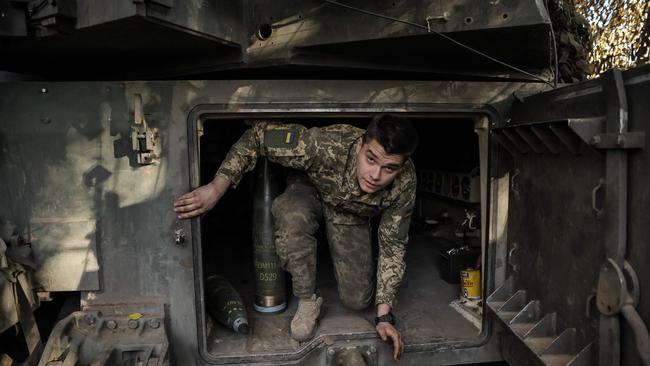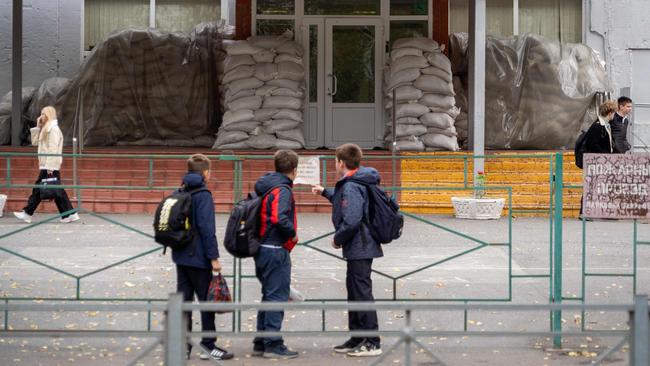Ukraine strikes deeper inside Russia, reshaping the war
Ukraine’s deep strikes inside Russian territory are being seen as a game-changer that could force Vladimir Putin into negotiating an acceptable peace.

Several times over the past three months, swarms of as many as 150 Ukrainian drones flew hundreds of miles into Russia, slamming into missile storage facilities, strategic fuel reservoirs, military airfields and defence plants.
Once considered exceptional, these deep strikes now barely register in the news. Yet, Ukrainian officials and some of their Western backers increasingly see the pain that long-range attacks inflict as a game-changer that could force President Vladimir Putin into negotiating an acceptable peace.
“Our capacity to return the war back to its home, to Russia, is what fundamentally alters the situation,” Ukrainian President Volodymyr Zelensky said after one such attack last month. The attack, according to open-source intelligence analysts, destroyed some 58 warehouses and a railway terminal at an artillery and rocket arsenal northwest of Moscow.
After meeting with US Defence Secretary Lloyd Austin this week, Zelensky said Washington is readying an $800m package to fund Ukrainian drone production.
So far, Ukraine’s long-range strikes – which have reached all the way to Russia’s Arctic shores in the north and areas bordering Kazakhstan in the east – have been executed with domestically produced weapons. In addition to drones, Kyiv has also targeted Russia with Ukrainian-made Neptune cruise missiles, although in much smaller numbers. Zelensky recently said that Kyiv has developed ballistic missiles, but they don’t appear to have been used yet.
While the US and its allies have allowed Ukraine to fight with Western weapons in Russia’s border regions, such as Kursk, they have repeatedly denied Zelensky’s requests to hit more remote Russian targets, such as military airfields, with ATACMS or Storm Shadow missiles that had been provided to Kyiv.

Putin has repeatedly warned of escalation should these Western missiles be permitted to hit inside Russia. Western officials say they fear that the Kremlin’s responses could include providing Yemen’s Houthis with sophisticated missiles that could sink US warships in the Red Sea, or stepping up sabotage activities in Europe. Russia has already provided the Houthis with intelligence to target commercial shipping.
Though not as potent or fast as ATACMS or Storm Shadow, Ukraine’s own long-range weapons have steadily increased in reach and power, turning from nuisance to a strategic lever in the war that is approaching a three-year mark. This development is a major shift from the first year of the war, when Russia pummeled military and civilian targets across Ukraine with drones and missiles without having to fear a significant response at home.
“When Russia alone had the capacity to hit the logistics and military infrastructure in depth, while Ukraine was limited to hitting only frontline targets, it represented a huge asymmetry to Russia’s benefit, ” said Mykola Bielieskov, a fellow at the National Institute for Strategic Studies, a government think tank in Kyiv. “So now we are showing our capabilities with rather effective strikes. The dynamic works in our favour because those who launch strikes hold the initiative, and Russia has a hard time defending its vast territory.” Ukraine is developing its long-range strike weapons at a critical moment of the war. Russian forces, aided by advantages in manpower and ammunition, keep slowly but steadily advancing in Ukraine’s eastern Donbas region, and are testing Ukrainian defences in the southern region of Zaporizhzhia.
The growing belief in Kyiv and among many of its backers is that the war in Ukraine cannot be won just in Ukraine – and that bringing it to an end requires inflicting much more damage to Russia’s economy and military infrastructure.
“A war of attrition in the South and the East is not a war that, over the long run, Ukraine can fight and win. So they have to figure out how to change Vladimir Putin’s calculus,” said representative Jason Crow (Democrat, Colorado), a US Army veteran who, like many Democratic and Republican lawmakers, is pushing the Biden administration to authorise the use of ATACMS inside Russia.

“Ukraine has the right to defend itself, and to do so requires them to strike — within Russia — the safe havens, the bases and the military logistics hubs that Russia is using to strike civilians within Ukraine,” he added.
Senator Roger Wicker (Republican, Mississippi), the ranking member of the Senate Armed Services Committee, complained in a letter to President Biden this month that Washington has “hamstrung” Ukraine’s military ability. He urged Biden to impose restrictions on Ukrainian use of ATACMS based “on the types of targets, rather than on the distance from a border that Russia doesn’t even recognise,” and to ship a “significant number” of the US military’s ATACMS inventory to Kyiv.
Russia’s previous threats of retaliation against American weapons supplies to Ukraine have turned out to be a bluff. But Putin’s warnings against hitting Russia with long-range Western missiles stand in a different category, cautioned Sam Charap, chair of Russia and Eurasia policy at Rand, a think tank based in Santa Monica.
“It’s the one explicit red line that the Russians have laid down. There is going to be pressure on them to act on this if it happens, just by the nature of the credibility problems that would be created if they don’t,” Charap said. “I could imagine them seeing a U.S.-enabled strike on targets deep in Russia as equivalent to a Russian strike on targets in Poland.” Austin, in an interview with Fox News last week, said that ATACMS strikes inside Russia wouldn’t change the course of the war because Russia has already moved its aircraft that launch glide bombs outside these missiles’ range. He praised Ukraine’s own “highly effective” drone capabilities.

Ukraine has already achieved mutual deterrence with Russia in the maritime domain through long-range strikes. Its attacks on the Russian Black Sea Fleet, and naval drone strikes on the port of Novorossiysk, have led to informal understandings that allowed last year’s reopening of Odesa, Ukraine’s main port, to international shipping.
Efforts to deter Russian strikes on Ukraine’s energy infrastructure have also been gaining strength, after systematic Ukrainian attacks on Russian refineries and a handful of large Russian power stations earlier this year.
Russian National Security Council secretary Sergei Shoigu, who served as defence minister until May, told Russian state TV in September that Putin had accepted a Turkish proposal to stop mutual attacks on energy infrastructure and commercial shipping in the Black Sea – but that Zelensky had rejected the idea. In any case, these indirect talks were derailed by the Ukrainian incursion in Russia’s Kursk region in August, according to Putin’s spokesman Dmitry Peskov.
Zelensky, at a press conference in Kyiv this month, said he in fact backed a mutual end to strikes on energy infrastructure and civilian shipping, saying that it could lead to an end of the “hot phase” of the war.
Meanwhile, the strikes go on. Ukraine was a major aviation manufacturer before the 2022 invasion, with global companies such as the Antonov aircraft company and the Motor Sich aircraft-engine maker. Currently, more than 20 different Ukrainian companies produce a variety of drones including the new Palianytsia that, with its reaction engine, comes close to being a guided missile. A large part of that production is funded with Western aid.
A Ukrainian officer involved in long-range attacks said that Western partners often participate in vetting targets, with strict restrictions to avoid civilian casualties, and provide intelligence and surveillance data to assess the results of these strikes. For a while, Ukrainian drones had to fly around Russian cities to avoid accidentally slamming into buildings not marked on maps, the officer said, a limitation that was dropped only after Russia bombed Kyiv’s Okhmatdyt children’s hospital in July.
After the recent wave of attacks on airfields, weapons warehouses and fuel reserves, Kyiv’s attention is turning to Russian defence industries. Several defence plants were attacked in recent weeks. “If Russia starts losing production lines, if Russian workers there start thinking that they could be hit whenever they go to work, that could have a strategic impact on the Russian Federation’s ability to wage war, ” said Anatoli Khrapchynski, a senior executive at a Ukrainian defence manufacturer.

For now, even as Russia continues indiscriminate attacks on Ukrainian cities, Kyiv isn’t hitting Russian targets that aren’t clearly connected to the military campaign.
Ukraine hasn’t attempted to disrupt Russian civil aviation, even though Russian attacks have grounded all Ukrainian civilian flights since February 2022. While blowing up refineries, Kyiv has also refrained from targeting Russia’s crude oil export facilities, a financial lifeline for the Kremlin, even though a significant part of these crude exports passes through the Black Sea and is within easy reach.
Such restraint is in part the result of Washington’s concerns about a spike in oil prices, particularly ahead of the November 5 elections. However, should Ukraine feel more pressure on the battlefield in coming months, these gloves could come off.
Serhiy Sternenko, a Ukrainian fundraiser who is providing drones to the military, pointed out that Western sanctions on Russian oil exports aren’t being properly enforced, and that oil sales to nations such as India provide Putin with critical funds for the war. Ukrainian strikes on Russian crude export terminals could be considered another form of economic sanctions, he said.
“It’s a war of survival for Ukraine,” Sternenko said. “We have to destroy everything that helps the enemy to continue the war against Ukraine.”
The Wall Street Journal



To join the conversation, please log in. Don't have an account? Register
Join the conversation, you are commenting as Logout